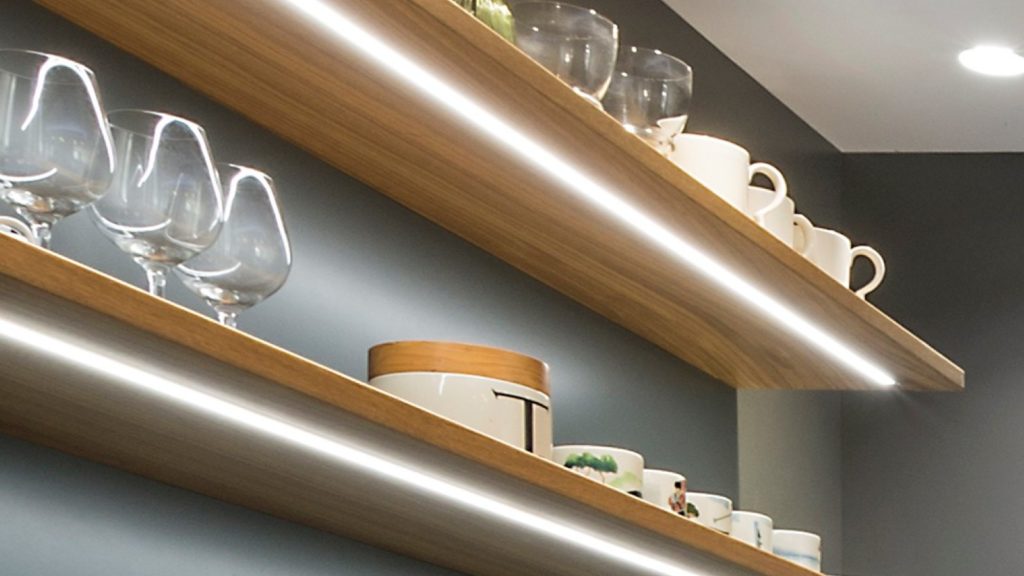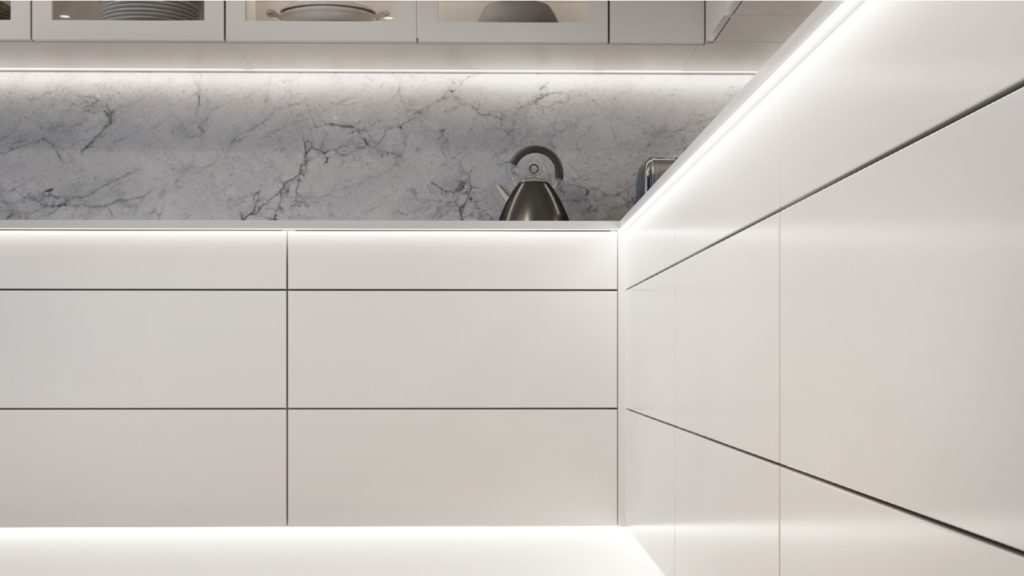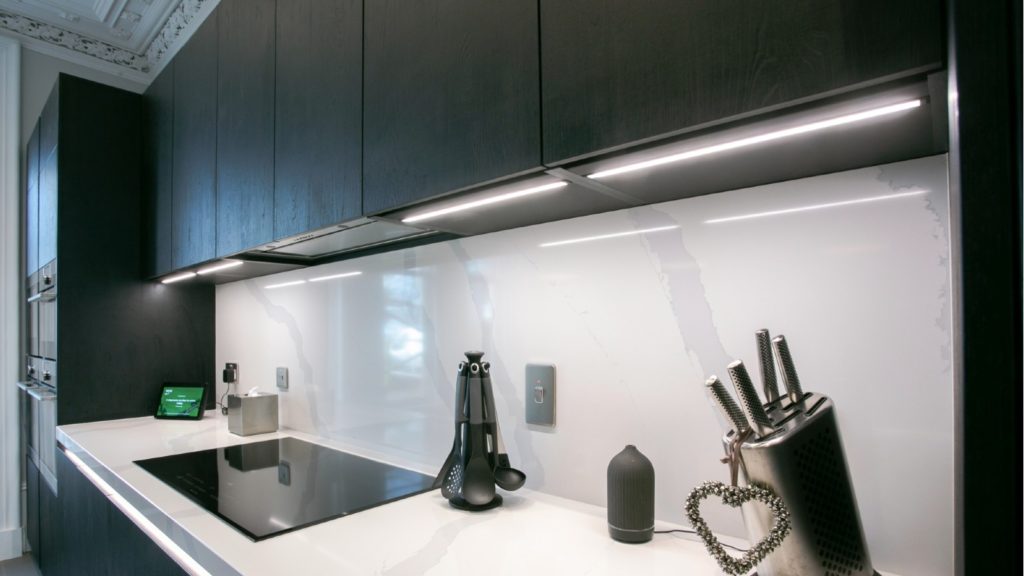With ever-evolving technology in LED tape, we reveal the latest dot less, colour changing and smart illumination in kitchen lighting.
LED tape may be the most popular lighting for the kitchen, with manufacturers claiming it provides between 50-70% of sales, but with ever evolving technology are designers aware of all the options?

Enabling retailers to order LED Flex tailored to particular specifications, Knightsbridge offers an online service to help choose IP rating, cable, strip lengths and add-on accessories.
Head of UK operations at Rotpunkt UK Matt Phillips comments: “I think the variety of options now available on the market might surprise them, giving them even more options to create user-friendly lighting schemes to support kitchen living 24/7.”
Sponsored Video
Along with wider choice it provides more opportunity to add illumination and grow potential profit, as TLW business development manager Daniel Hughes points out: “Many kitchen designers are surprised by the amount of profit that can be made by integrating lighting into their kitchen designs.”
So, what are the latest developments driving lighting design? Dot less, colour changing temperatures and smart lighting, are just some of the latest developments driven by manufacturers, to enhance the functionality and aesthetics of the kitchen.
Dot free lighting
There has been a move for LED tape which provides continuous lighting, rather than light emitted in dots. It has seen the use of diffusers and, most recently, chip-on-board (COB) lighting.

LED strips from Leyton Lighting can be used to illuminate under shelves and is available in a wider range of colour temperatures and aluminium profiles
Shaun Barker, product manager of Hafele UK, explains: “COB Ribbon upgrades are one of the latest developments in LED strip lighting, COB ribbons provide a ‘no dot’ effect lighting without the need for profiles or profile covers, and are especially suited to plinths and under cabinets where close proximity to a surface can reflect the LED diodes.”
Sales and marketing director of Leyton Lighting Ashley Smith agrees and points out dot less tapes are the most popular type of LED sales for his company: “The fastest-growing products in our portfolio are the dot less tapes as customers who are spending money on quality cabinetry and worktops do not want to see dots reflected in these surfaces.”
Colour changing LED
It’s not only how light is emitted but also the choice of temperature or colour, which is growing in importance for LED tapes.

Providing a variety of tapes and profiles, LED lighting from TLW can be used to illuminate under cabinets, worktops and plinths
This is particular true for clients interested in the growing trend for indoor kitchen gardening. Shaun Barker of Hafele points out: “Full spectrum lighting can be used to grow plants, small vegetables, or seedlings where space and sunlight is lacking.”
But for more general lighting, designers could use tape which can change colour temperature from pure white through to warm white to suit all times of day.
Ashley Smith of Leyton Lighting points out: “Another increasing trend is the growing demand for different colour temperatures, with extra warm tapes proving to be very popular with the popularity of darker woods and colours.”
While product manager at Knightsbridge Molly Ho points to LED tape which can offer a spectrum of colours: “There has been a marked increase in interest for colour changing RGBW (Red Green Blue White) options, which provide a ‘one type fits all’ solution and add to the adaptability and fun side of LEDs.”
Smart advances
To simplify how to choose and control lighting, manufacturers have created smart lighting which can be controlled by remotes, apps and now even voice assistants.
Marketing manager at 4lite Rachel Morris explains how smart lighting is impacting on her company’s sales: “Our smart strip lighting products are both the best-selling and fastest-growing in our collection.
“This is because they offer so many added benefits – from the opportunity to select millions of colours, alongside tuneable whites to suit different moods and times of day, through to the easy control via the WiZ app or voice-controlled smart devices such as Google Home, Alexa, Siri and Samsung Smart Things.”
Simplifying specification
Designers could be forgiven for thinking specifying smart lighting could add complexity to the process.

Using Rotpunkt smart-ready LED lighting integrated into furniture, John Willox Kitchen Design created a kitchen scheme which included under cabinet illumination
But as Shaun Barker of Hafele points out: “Actually it’s really easy. Our Loox range, for example, offers plug and play technology meaning that in most cases an electrician isn’t required for installation.”
While Rotpunkt has integrated smart ready lighting into its cabinetry. Matt Phillips points out: “I think the idea of ‘separate lighting’ will begin to change as we move towards a much more integrated smart kitchen from the very beginning of the design process.”
In fact, even with separate lighting, kitchen designers don’t have to become lighting experts. Manufacturers also provide design services from aiding specification through to creating the scheme from room plans.
So don’t be put off by lighting design, as Daniel Hughes of TLW concludes: “Without selling any more kitchen, designers can often grow their sales by adding lighting to as many projects as possible.”



